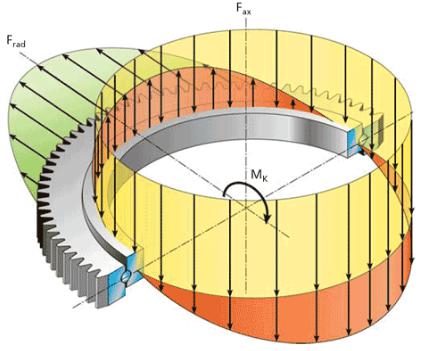Views: 531 Author: Site Editor Publish Time: 2019-04-17 Origin: Site








During the use of the slewing bearing, it is generally required to bear the joint action of the axial load force Fa, the radial load force Fr and the overturning moment M. For different applications, due to the different working modes and structural forms of the main machine, the combination of the above three loads The situation will change, sometimes it may be the combination of two loads, and sometimes it may be just a separate effect of a load.
A slewing ring is a contained system of balls or rollers, caging, raceways, mounting provisions, and often, integral gearing as well. These large units are designed to transmit axial load, radial load, and tilting moment loads. And because they handle loads (and different combinations of them) in one assembly, these bearings eliminate weight, space, and cost penalties of other rotational designs.
Slewing bearing Calculation and selection according to the loading force
The most suitable slewing ring for a design depends on static and dynamic loads, bolt requirements, and gearing specifications.. How are loads on a slewing ring best calculated? By using the classical engineering approach of creating free-body diagrams and then solving for unknown variables using static equilibrium equations. (Such a sketch shows forces, their vectorial direction in terms of X and Y Cartesian coordinate values, and the X and Y perpendicular distances of these forces relative to the bearing center.) The bearing plane becomes a cut line for the free-body diagram dividing forces — left and right or top and bottom relative to the bearing plane. Bearing loads are simply the reaction forces at the cut plane. Equations of static equilibrium return reactionary forces at this plane are:
Σ Axial forces = 0
Σ Radial forces = 0
Σ Moments = 0

The directions of force and moment rotation are very important, indicating whether a value is positive or negative. Moment loads are calculated about the center of the ring — that is, where the center plane and rotation axis of the ring cross.
The importance of large slewing ring bearing maintenance in lifting equipment
In lifting equipment, the large diameter bearing serves as a joint between the upper structure and the undercarriage, providing a means of 360-degree rotation. Lifting devices typically have a complex load spectrum: the slewing ring bearing can simultaneously handle all combinations of thrust, radial, and tilting moment loading. The use of a slewing ring bearing provides yet another benefit: its shaftless design eliminates the need for a spindle or kingpost. The center of the bearing remains open to allow passage of various hydraulic and control components.
Inadequate lubrication is the most common cause of premature bearing failures. In slewing ring bearings, a heavy-duty, extreme pressure grease is required. When lubrication is inadequate, surface damage in the form of roughening or waviness occurs. Later, fine cracks develop, followed by flaking
While maintenance is critical to lengthening the life of large slewing ring bearings, the severity of use of heavy equipment means that eventually, any large slewing ring bearing will become worn. Detection of bearing wear makes repair a less costly alternative to replacement. If you practice proper maintenance and watch for common warning signs, a worn bearing is likely to be deemed repairable.
Invitation to Visit Xuzhou Wanda Slewing Bearing Co., Ltd. at Bauma 2025
Anti-rust advice for stocked slewing bearings of XZWD company
Xuzhou Wanda slewing bearing successfully delivered a 5 meters slewing bearing for floating crane
The Surface Treatment of Slewing bearings: Painting, Zinc spraying, Zinc Plating, Nickel Plating.
Home | About Us | Products | News | Application | Support | Contact Us


